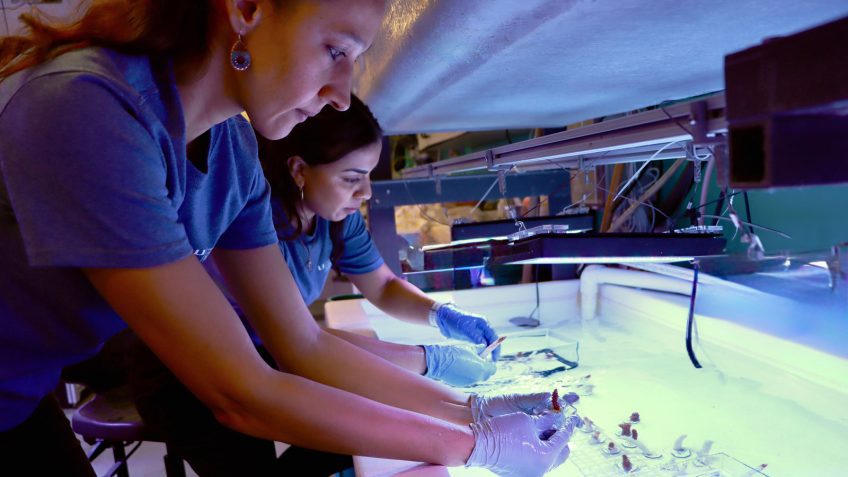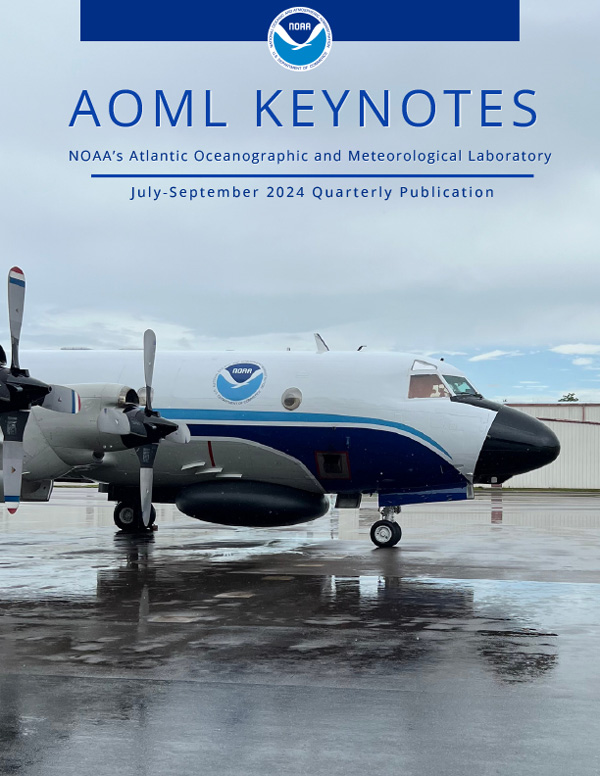Stony Coral Tissue Loss Disease (SCTLD) is the deadliest known coral disease to species with a hard skeleton (i.e., Scleractinians), causing rapidly-expanding, bare lesions to form across a coral’s skeleton until there is no more living tissue. The pathogen or microbes leading to the spread of this disease have yet to be identified. Yet scientists […]
Read Full Article
The ocean and the atmosphere are constantly seeking balance. Gases like oxygen, nitrogen, and carbon move between the ocean’s surface and the atmosphere by billions of metric tons every year. A higher concentration of one gas in the atmosphere leads to more of that gas being taken up by the ocean as the two try […]
Read Full Article
Water masses move over reefs, seagrass beds, and sandbanks – and as they do, the seawater chemistry changes. In the Florida Keys, changes in coral reef carbonate chemistry are driven by benthic metabolism, the origin of the water mass, and the connectivity of habitats. A new study from NOAA’s Atlantic Oceanographic and Meteorological Laboratory (AOML) […]
Read Full Article
After nearly 40 days at sea, the I09N GO-SHIP cruise (short for “Global Ocean Ship-based Hydrographic Investigations Program”) aboard the R/V Thomas G. Thompson arrived in Phuket, Thailand on April 27th, successfully completing its mission surveying both the Indian Ocean and Bay of Bengal. After departing from Fremantle, Australia on March 21st, the international team of researchers spent weeks collecting data essential for investigating global changes in ocean physics, chemistry, and biology.
Read Full Article
Research Highlights July 9, 2025New study reveals record heat and rapid cooling in equatorial Atlantic in 2024July 2, 2025New study indicates Stony Coral Tissue Loss Disease may be inhibited by warmer waters June 25, 2025Ocean Month: Exploring and understanding our ocean through research cruises Research Interests Evan Josza Research Associate (University of Miami/CIMAS), Ocean Chemistry and [...]
Read Full Article
For the past three years, scientists at NOAA’s Atlantic Oceanographic and Meteorological Laboratory (AOML) and the Cooperative Institute for Marine and Atmospheric Science have been uncovering the secrets behind the extraordinary resilience of corals in PortMiami. Now, you can dive into their groundbreaking research like never before with a new virtual reality experience, Unlocking the […]
Read Full Article
Research Highlights December 7, 2022New study finds that seventy percent of Florida’s coral reefs are erodingNovember 17, 2022Congratulations to the Winners of 2022 Department of Commerce and NOAA Awards!August 8, 2022Coral Rescue in Miami Beach Research Interests My research interest is in coupling biogeochemical dynamics between benthic and pelagic systems; calcium carbonate geochemistry; and exploring [...]
Read Full Article
South Florida is comprised of 350 miles of the only barrier coral reef in North America – and the third largest in the world. 1,800 miles of shoreline is lined with mangroves in the Florida Keys alone, which provide coastal protection from storms and support juveniles of commercialized fish species. The region sustains the largest […]
Read Full Article
In a new study, scientists at AOML and the University of Miami’s Cooperative Institute for Marine and Atmospheric Sciences (CIMAS) demonstrated how some genotypes of the reef-building coral Acropora cervicornis (Staghorn Coral), listed on the Endangered Species Act, proved resilient when exposed to high nutrient levels or disease, but not when the two stressors were […]
Read Full Article
Diver’s drop over the gunnel. Tanks, weights, divers, and a mesh bag full of tools all descend in emerald waters beneath grey skies. Off the vessel’s bow, a yellow beacon blinks with a red flashing light and a thin data cable stretching to the seafloor, all connected to a suite of sensors twenty feet below […]
Read Full Article








